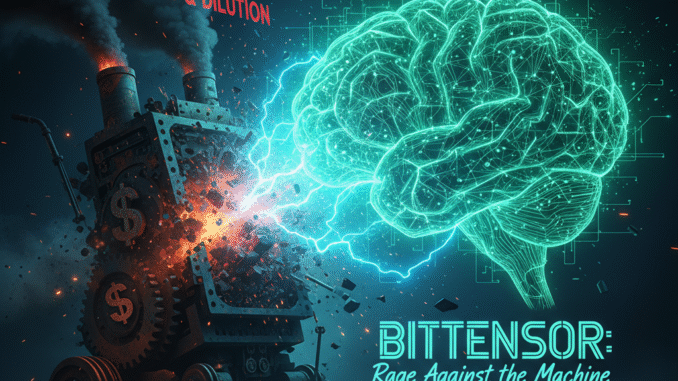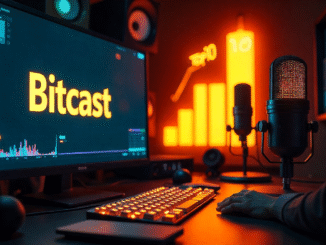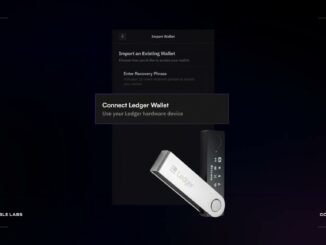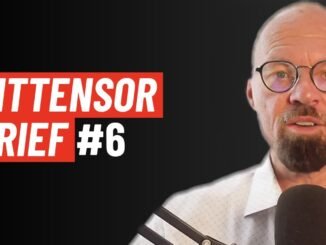
Contributor: School of Crypto
People are fed up. The dollar keeps losing value as fiat currencies get printed into oblivion. Early investors have watched their equity shrink through endless funding rounds. Dilution is the way of the world. There is no more scarcity anymore.
Well, this all changed when Bitcoin was invented. A finite supply of 21 million coins was set, and there was no extra issuance to be had. But is Bitcoin enough of a powerhouse to tackle all the hyperinflation and dilution currently in the world? Probably not. That’s why Bittensor was created — to show rage against the value-dissipating machine of fiat currencies and startup investing.
The dilution problem
This inflation/dilution conundrum was brought up in the latest Tao Pod episode featuring James Altucher and Joseph Jacks. James was once a VC, and Joseph is a current VC founder with OSS Capital. Both invested early in a startup that surged 600x in value, yet endless dilution left them with only a 50x gain.
This anecdote isn’t just an example of an isolated VC startup problem. The crypto industry itself has many fully diluted market cap projects. Lots of these companies have billions of dollars worth of coins reserved for early-stage investors and founders.
Why Crypto made it worse
Crypto was meant to be a haven of decentralization. Instead, many projects have fallen into the same traps of greed and mismanagement as the systems they sought to replace.
Curve Finance is a cautionary tale of a founder (Michael Egorov) being liquidated based on a CRV-backed loan that went under, leading to a massive sell-off. The Curve Finance holders were victims of the founder’s incompetence.
In terms of high-float, fully diluted market caps, Chainlink has allegedly sold hundreds of millions of dollars worth of LINK, making a direct influence on its market price.
Former co-founder of Ripple and current CEO of Stellar Lumens Jed McCaleb, has reportedly sold off XRP to fund his current project, leading to big moves to the downside.
Block.one raised billions of dollars to form EOS only to dump on retail investors, leading the price to precipitously fall from $22 to $3.
Bitcoin’s partial solution
“The main emotion I feel when I think of why one should buy Bitcoin is outrage” – James Altucher
The year 2009 marked a watershed moment in the way we view money in this world. Satoshi Nakamoto, the pseudonymous creator of Bitcoin, introduced a new way to transact. They stated in the Bitcoin whitepaper: “What is needed is an electronic payment system based on cryptographic proof instead of trust, allowing any two willing parties to transact directly with each other without the need for a trusted third party.”
Bitcoin rewards miners for solving cryptographic puzzles that secure the network with no central authority required. Each and every user relies on the system to work in a trustless fashion.
Before Bitcoin, citizens of a country needed to hope and pray that the government and Central Bank would preserve their wealth via their domestic fiat currency. What history has taught us is that countries continue to inflate fiat currency and participate in massive government spending campaigns. Citizens are left holding a bag of fiat worth less than when they earned it.
Bitcoin provided a finite supply of 21 million coins with halving issuance every 4 years. No other BTC can be minted or mined other than what was written in code. This novel and genius architecture opened the hearts and minds of people all over the world and gave it trust because of its trustless, genuine nature and design. Now Bitcoin stands as an ideal storage of wealth that’s compared to the precious metal gold.
“Tao: Reserve currency for continuously improving technology” -Joseph Jacks
Bittensor takes a similar page out of Bitcoin’s book in terms of its tokenomics. The reserve currency Tao will only have 21 million coins ever mined in the ecosystem. Like Bitcoin, no tokens were pre-mined or gifted to insiders. Every TAO was earned through mining or open-market purchase.
Based on these tokenomics, investors and community members of Bittensor don’t have to worry about any token unlocks or big whales dumping their coins on the open market.
The second layer of the Bittensor ecosystem is Dynamic TAO (dTAO). The network is made up of individual subnets, or projects that focus on their own respective use cases. Currently there are a total of 128 subnets running in Bittensor. Each subnet has its own token supply of 21 million, the same as TAO itself.
A liquidity pool of TAO and subnet tokens is infused in every subnet on Bittensor. The amount of emissions divvied out to subnets depends on the amount of investors staking into the pool.
As with TAO itself, the subnet token supply will never get diluted and will always lead to a maximum supply of 21 million tokens. None of these subnets have tokens allocated to subnet owners, founders, or early investors.
The market-driven tokenomics of the dTAO ecosystem rewards liquidity and emissions to the highest-performing subnets as opposed to unnecessary hype and fool’s gold promises. Akin to early stage investing, dTAO investors can earn more TAO if the projects succeed, but can lose TAO if they don’t deliver as promised.
VCs have invested in Bittensor but play by different, fairer rules
Bittensor embodies the true ethos of scarcity, non-dilution, and true value. However, it has still been engaged with by major VCs within the space. Polychain Capital has invested in Bittensor in the very early stages. Digital Currency Group, led by famed Bitcoin investor Barry Silbert, has invested hundreds of millions of dollars in Bittensor. Crucially, these investments came post-launch. VCs bought or mined TAO just like everyone else.
What about the effect VCs have on the subnets themselves? Yuma, a DCG subsidiary, has participated in accelerating and incubating a total of 14 subnets in the Bittensor ecosystem. Joseph Jacks’ OSS Capital led a Series A $10.5 million investment in Manifold Labs, owners of the GPU compute subnet, Targon.
DSV Fund, a venture capital firm solely dedicated to Bittensor, has made multiple six-figure OTC investments in subnets across the ecosystem, including Ridges, Synth, Sportstensor, and many others. OSS Capital, Yuma, and DSV Fund have contributed value to subnets after TGE without any pre-mined tokens to speak of.
Does Scarcity and Anti-Dilution Ensure Fairness and Efficiency?
While the mechanics of Bittensor redefine value in a fairer and more equitable fashion, there are still hurdles for the protocol to leap over that challenges its scarcity selling point.
Currently, the top 15 subnets earn half of all TAO emissions. The competition is healthy, but does it leave smaller subnets struggling to survive? Pareto’s principle states that 80% of effects come from 20% of the cause. This dynamic of the top subnets getting the most emissions is no exception to this widely known concept.
The first Bittensor halving is scheduled on December 11th, 2025. Bitcoin showcased the bullish effect of reducing supply in half every 4 years. The price of BTC always went up based on these watershed halving events.
In the case of Bittensor, there are a few more variables in place. Subnets rely on emissions in order to incentivize miners, stakers, and keep the lights on themselves. Once the TAO emissions get slashed in half, will there be enough liquidity to serve all these parties?
Essentially the price of TAO needs to appreciate in order to keep all participants profitable and afloat. In the event the price remains, there will be less TAO to earn, leading to the potential of miners, validators, and investors allocating their funds elsewhere. If TAO follows the same path BTC did after halving, history suggests higher price action is a formality.
Another factor that affects liquidity for subnets is the friction obtaining alpha tokens. While the average user can buy TAO coins on major exchanges, there are still hurdles involving obtaining the actual subnet alpha tokens via sending TAO to a wallet, selecting a validator, and staking. This process is still permissionless, however the lack of technical know-how or access restricts the common crypto investor.
The good news is there are subnets that have created services to give access to investors who are more comfortable and familiar with other blockchains. For example, Subnet #10, Swap, has created a smooth front end AMM on the Base blockchain for users to swap USDC for TAO and directly into a subnet alpha token. VoidAI also provides a similar slick front end for users to provide liquidity and swap TAO for alpha tokens via Solana. This greatly breaks the barriers to entry for outsiders.
Hippius also recently announced their subnet token will be listed on MEXC exchange, which is an encouraging sign for other listings down the road for more subnet alpha tokens.
Incentive Design Challenges: Aligning Participants and Preventing Gaming
The anti-inflationary makeup of TAO and non-diluted nature of dTAO doesn’t shield subnet owners from other blind spots within the ecosystem. Incentive mechanisms have to make sense financially in order to stay alive. Subnets also need to be cognizant that their incentive mechanism can’t be gamed by miners and in turn, diluting the alpha token supply to actors that don’t properly earn them.
Bittensor is going through a subnet deregistration phase. This action is intended to get rid of subnets that don’t provide value to the ecosystem. Community members are speaking out against a subnet called Polaris being on the brink of deregistration. GXG tweeted that the subnet has a live product, is active on X, hasn’t sold off alpha tokens, and shows solid activity on Github.
Jacob Steeves, the founder of Bittensor, weighed in on the issue, offering insights into how subnets should design their incentive mechanisms. He noted that Polaris operates as a pure compute commodity subnet, burdened by high costs and slim margins. This setup yields little in terms of tangible returns for their services. It also positions them to be outperformed by neutral subnets, which spend nothing and gain nothing in return.
Given all this information, is all fair in love and competition, and does survival of the fittest override all these good deeds? Ultimately as in regular capitalism and economies, it’s the market that decides who stays and goes. If a subnet doesn’t properly incentivize investors/miners/validators to participate, then it will not be able to keep its doors open.
Another pitfall that can spell disaster is the scenario in which miners game the system in return for more rewards. The fear for subnet owners is sybil attacks, or in other words, bad actors creating a large number of submissions on their network to disproportionately gain more rewards.
Subnet owners have picked up on these reward tactics and have adjusted accordingly. As illustrated in a prior article, Bitcoin prediction subnet Mantis successfully created a “novel design with lightweight codebase at just 1,400 lines essentially makes copycats and redundant non-unique signals very unprofitable”.
As discussed in a Revenue Search episode, Sportstensor made their incentive mechanism very tightly designed to reward proven winners with consistent signals – not reckless actors with spurious results. The subnet also won’t pay more in alpha tokens then the revenue they take in from the qualified volume that miners provide, making their alphanomics anti-dilutive by design.
Without proper checkpoints in place, subnets are prone to getting exploited by miners, which in turn, dilutes investors, subnet owners, and validators alike.
Bittensor is the Rage Against the Machine
The machine is something we’ve lived with and accepted all our lives: an amalgamation of nations’ monetary downfalls. It constantly funds companies that dilute early investors’ opportunities. Bank customers earn pennies on the dollar in yield on their savings. Venture capitalists must trust startups to act in good faith and avoid share dilution for the best possible returns.
It’s one vicious cycle. The machine fires on all cylinders while fiat money’s value is set on fire and early investors’ share allocations go up in flames.
Bittensor channels the rage of fiat holders and startup investors straight into the machine. The TAO token delivers hard utility value with a strict hard cap and a halving schedule every four years, ensuring scarcity. TAO powers incentivized intelligence through validating, launching subnets, mining, and staking in the Bittensor ecosystem.
dTAO alpha tokens deliver the non-dilutive share value that startups ought to provide in the real world. With subnets, there are no A-through-Z seed rounds. Mine or invest in a subnet, and you receive your allocation—end of story.
Bitcoin brought hard money and a true store of value to the world. Bittensor follows suit, combining a hard-utility coin in TAO with non-dilutive subnet alpha tokens to protect people’s wealth and investors’ stakes. Call it rage against the machine.




Be the first to comment